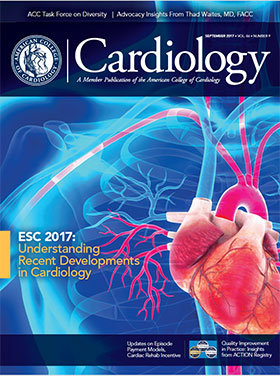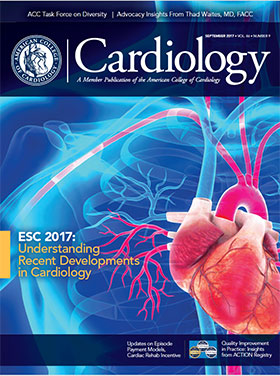Intra-atrial re-entrant tachycardia (IART) is the most common atrial arrhythmia in patients with congenital heart disease, with significantly higher rates in patients with a more complex disease, according to a study published in the Journal of the American College of Cardiology. However, the study also finds that atrial fibrillation (AFib) increases in prevalence — surpassing IART— and atrial arrhythmias become more permanent as patients age.
Among the 482 patients, 54.8 percent were women and the mean age was 32 ± 18 years. The type of congenital heart disease was classified in patients as simple (18.5 percent), moderate (34.4 percent) and complex (47.1 percent).
Results showed the most common arrhythmia was IART at 61.6 percent (mean age, 28.8 ± 16.8 years), followed by AFib at 28.8 percent (mean age, 41.0 ± 17.2 years) and focal atrial tachycardia at 9.5 percent (mean age, 23.6 ± 18.5 years).
The number of arrhythmias from IART increased with congenital heart disease complexity from 47.2 percent to 62.1 percent to 67.0 percent in patients with simple, moderate and complex defects.
"The number of arrhythmias from IART increased with congenital heart disease complexity from 47.2 percent to 62.1 percent to 67.0 percent in patients with simple, moderate and complex defects."
AFib, on the other hand, increased with age and became the most common arrhythmia in those 50 years and older. Out of 136 patients who were at least 50 years old by the end of follow-up, 73 (53.7 percent) had developed AFib.
In multivariable analyses, older age (odds ratio [OR], 1.024 per year; 95 percent confidence interval [CI], 1.010-1.039) and hypertension (OR, 2.00; 95 percent CI, 1.08-3.71) were independently associated with AFib.
Over the course of a mean follow-up of 11.3 ± 9.4 years, the predominant pattern of atrial arrhythmias in patients was paroxysmal in 62.3 percent, persistent in 28.2 percent and permanent in 9.5 percent.
Paroxysmal and persistent arrhythmia patterns declined from ages 20 to over 50 years. However, permanent arrhythmias increased with age, from 3.1 percent in patients under 20 years to 5.5 percent, 12.9 percent, and 22.6 percent for ages 20 to 34 years, 35 to 49 years, and 50 years and older.
In an accompanying editorial, Michael J. Silka, MD, and Yaniv Bar-Cohen, MD, comment, “The study provides some useful insights and, perhaps more importantly, raises further questions about the next sequel or possibly series of events as these patients survive into and beyond middle age.” They add, “It becomes critical to define the relative risks for the development of AFib, to determine which specific forms of CHD are associated with the development of AFib, and finally, to establish whether there are therapeutic measures of demonstrable benefit or prevention.”
Labombarda F, Hamilton R, Shohoudi A, et al. J Am Coll Cardiol 2017;70:857-65.
<<< Return to top





